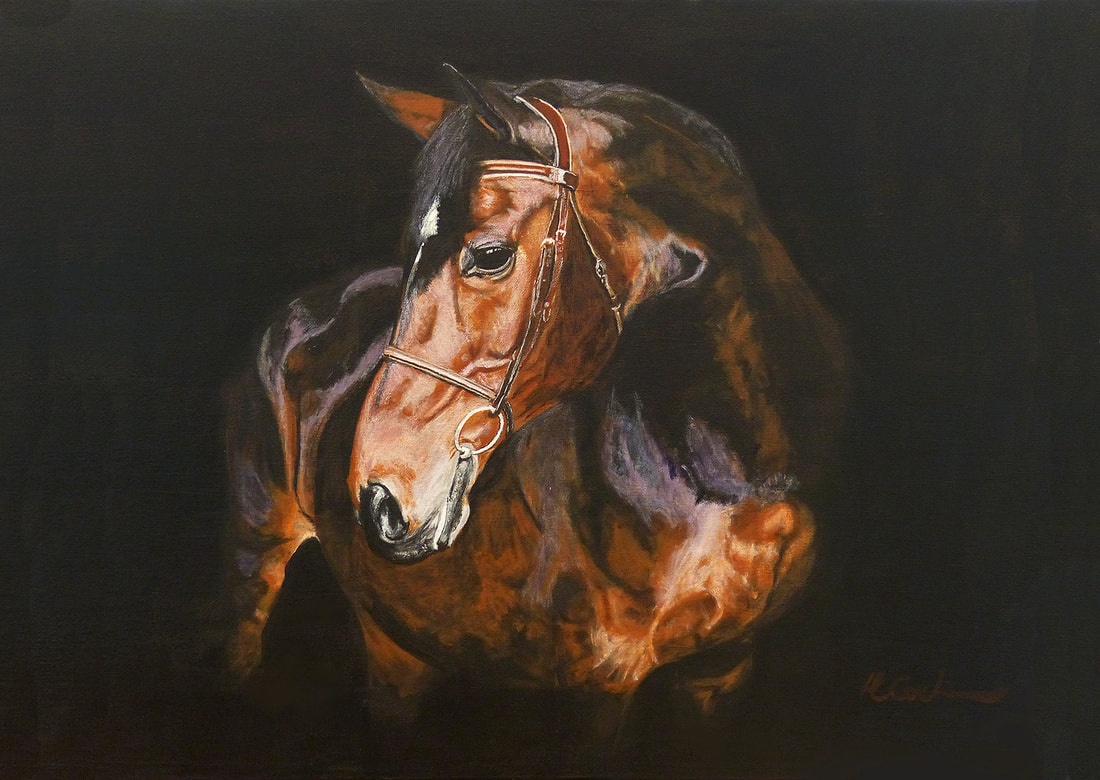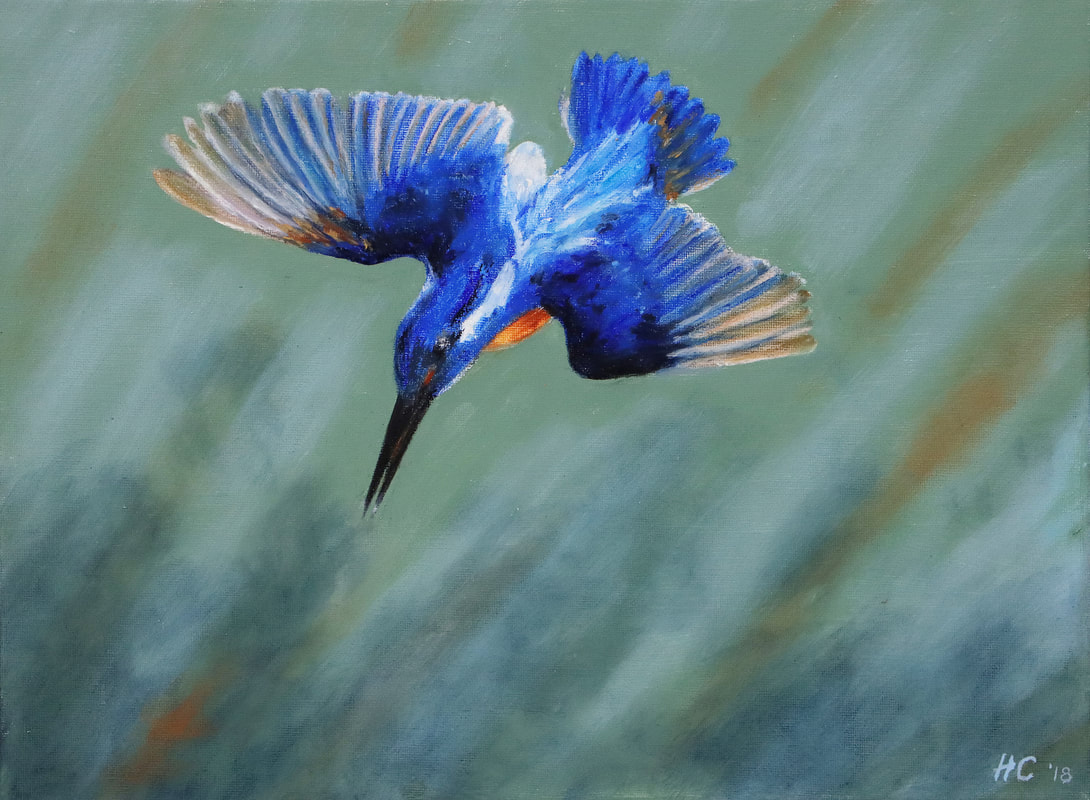The Art of Helen Cochrane
Murwillumbah
|
I only started art classes in May 2018 so I'm very new to this fabulous pastime. With a love of horses and all wildlife I am thrilled to be learning techniques to paint these beautiful creatures and the places where they live.
Based in the Northern Rivers area of NSW for the last 40 years I have ventured to America and Africa on horse riding safaris. Furthermore, as a keen amateur wildlife photographer I can now turn my images into paintings. After being permanently flooded out of my home during the in historic 2017 Tweed River flood disaster, I moved to temporary accommodation above the Courthouse Hotel in Murwillumbah. Very fortuitously, the Caldera Wildscapes Gallery is also in the same building and I became a student of art tutor Andy Reimanis and haven't looked back. I'm now an 'artist-in-residence' in the gallery and have completed 26 paintings with sales steadily increasing. I love the challenge of a commission and welcome them wholeheartedly. |
|
Racing! Acrylic I was inspired to create a painting of this 'close-up' image since it encapsulates the raw power of horses when galloping at full tilt. The horse racing industry is highly competitive and a very popular sport with huge audiences worldwide. The Melbourne Cup in particular is a well known race, an 'institution' that is celebrated annually in Australia. To depict the movement and complexity of muscles and tendons, let alone who's leg was who’s, was quite challenging. |
|
Horse Portrait Study #1 Acrylic This portrait of a horse was my first attempt at equine art. After starting art classes in May 2018 this painting is my seventh completed project. It has triggered a passion for fine art and I hope to pursue a career in this field. I’ve always loved horses and been fortunate enough to have owned four during my time in the Tweed. The rolling green hills and crystal clear creeks make for an ideal environment to pursue equine pleasures. Learning painting techniques to depict hair, fur and skin of an animal was initially frustrating but very rewarding. Persistence and patience appear to have paid off and I am proud of my achievements so far. |
|
The Grey Wolf Acrylic Found in the wilderness and remote areas of Eurasia and North America (where it is also known as the timber wolf) the wolf is the ancestor of domestic dogs. It is a top predator and by living and hunting in packs it enables them to bring down large prey such as deer, elk and moose. Some smaller mammals such as rodents and rabbits, as well as carrion, form part of their diet. Learning the techniques of fine art has excited and inspired me to try representing some of my favourite animals of North America after travelling there in 2007. |
|
The Tembo Twins Acrylic These sweet little elephant twins reminded me of my African adventures in 2012. With Masai guides leading, we met three huge adults quenching their thirst at a watering hole. This elephant mothers’ overall bulk and powerful presence inspired me to try and capture this in a painting. The toughness and wrinkly skin texture was an interesting challenge to try to depict. The shape of an African elephant’s ears (coincidentally in the shape of Africa) are different to the smaller ears of the Indian elephant. 'Tembo' is Swahili for elephant so I used this title for respect to the country, its people and this incredibly magnificent animal. |
|
Brumbies Acrylic Brumbies are free-roaming feral horses found in many parts of Australia but best known in the Alps region. They are descendants of escaped or lost horses dating back (in some cases) to European settlers. Occasionally they are mustered and domesticated. Brumbies are a subject of much controversy since their hard hooves are a threat to alpine ecosystems. I love the look of these wild horses. Dishevelled and scarred they show their endurance to survive for many generations in a harsh environment. I would like to thank Jason Edwards for permission to use his photograph as a reference for my painting. |
|
Simba - Swahili for Lion Acrylic During my amazing camping and horse riding safari in Kenya in 2012 a lion came in the night to inspect our horses. The Masai who were protecting us soon dispersed the predator by jointly “shooing” it away. Lions have great respect for the Masai and vice versa. Much respect on all accounts followed that encounter! The male lion is most recognised for its prominent mane. This was a challenge to paint since it has to appear 'shaggy' yet majestic. The image of the lion has been depicted for thousands of years - in cave paintings, crests and emblems, it symbolises power, majesty, strength and courage. |
|
Azure Kingfisher Oil pastel With its combination of royal blue and orange plumage the Azure Kingfisher is one of the most dazzling kingfishers in Australia. This diminutive species lives alongside waterways where it perches on low overhanging branches looking for prey (small fish, crustaceans and aquatic insects). These are then captured with a steep dive into the water. I have always liked this little fella's beautiful colours and am delighted whenever I spot one. He was a challenge to paint since this is only my second attempt at a serious painting and am rather chuffed at the outcome . |
|
Genghis Acrylic Herds of Mongol horses have remained pure bred since the days of Genghis Khan roaming the plains of Mongolia. Being small but sturdy, they have a huge amount of stamina and hardiness to endure extreme climatic living conditions. These horses are an integral part of the social culture of Mongolia and are used for transport as well as racing. The mare's milk is an important part of the Mongol people's diet. I love the shaggy, windswept appearance of these horses and admire the Mongols understanding and respect for such a beautiful animal. It was a challenging project to paint the complex textures of such a wild and free animal. |
|
The Plains Zebra Acrylic The plains zebra is found throughout much of southern and eastern Africa south of the Sahara, although herds are often fragmented. Great variations in stripe patterns exist within individuals. Their habitat is generally treeless grasslands and savannah woodlands. Being highly sociable animals, they form harems with a single stallion and several mares. After travelling to Kenya in 2012 I had the privilege of riding a horse amongst large herds who were not threatened by my presence at all. It was certainly a thrilling experience I treasure greatly. |
|
Fleay's Barred Frog Oil pastel The Fleay’s Barred Frog lives in wet forests in south-east Queensland and north-east NSW. Along with other species in the Mixophys genus (the Giant, Great and Northern Barred Frogs) they are listed as threatened. Adults often hide in leaf litter near permanent fast flowing streams in rainforests and are quite large (up to 90 mm) yet very well camouflaged. They are unfortunately often mistaken for Cane Toads. I became interested in this frog when I learned of it through a ‘threatened species’ project our art class were involved in for the Tweed Shire Council. I find its appearance so interesting and unique. I had fun painting the wonderful cryptic colours and features. |











